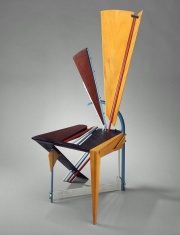Difference between revisions of "Anodized aluminum"
Jump to navigation
Jump to search
(username removed) |
|||
| (3 intermediate revisions by 3 users not shown) | |||
| Line 1: | Line 1: | ||
| − | [[File:1985.732-SC16735.jpg|thumb|]] | + | [[File:1985.732-SC16735.jpg|thumb|Aluminum chair<br>MFA# 1985.732]] |
== Description == | == Description == | ||
| − | Metallic [ | + | Metallic [[aluminum|aluminum]] naturally forms a thin, transparent oxide layer that provides corrosion protection. Anodizing is an electrochemical process that quickly builds-up this oxide layer. Anodized aluminum is usually silver, gray, or brown, but the layer readily absorbs dyes of any color. The electrochemical process for anodizing was first developed in the 1920s and was initially used for electrical applications. After World War II, anodized coatings became popular for architectural construction because of their corrosion resistance and decorative colors. |
== Synonyms and Related Terms == | == Synonyms and Related Terms == | ||
| − | aluminium | + | aluminium anodisé (Fr.); alumínio anodizado (Port.); |
| − | == | + | ==Resources and Citations== |
| − | * | + | * Random House, ''Webster's Encyclopedic Unabridged Dictionary of the English Language'', Grammercy Book, New York, 1997 |
* ''The American Heritage Dictionary'' or ''Encarta'', via Microsoft Bookshelf 98, Microsoft Corp., 1998 | * ''The American Heritage Dictionary'' or ''Encarta'', via Microsoft Bookshelf 98, Microsoft Corp., 1998 | ||
| − | * | + | * Thomas C. Jester (ed.), ''Twentieth-Century Building Materials'', McGraw-Hill Companies, Washington DC, 1995 |
| − | * | + | * Tom Rowland, Noel Riley, ''A-Z Guide to Cleaning, Conserving and Repairing Antiques'', Constable and Co., Ltd., London, 1981 |
[[Category:Materials database]] | [[Category:Materials database]] | ||
Latest revision as of 12:35, 27 April 2022
Description
Metallic Aluminum naturally forms a thin, transparent oxide layer that provides corrosion protection. Anodizing is an electrochemical process that quickly builds-up this oxide layer. Anodized aluminum is usually silver, gray, or brown, but the layer readily absorbs dyes of any color. The electrochemical process for anodizing was first developed in the 1920s and was initially used for electrical applications. After World War II, anodized coatings became popular for architectural construction because of their corrosion resistance and decorative colors.
Synonyms and Related Terms
aluminium anodisé (Fr.); alumínio anodizado (Port.);
Resources and Citations
- Random House, Webster's Encyclopedic Unabridged Dictionary of the English Language, Grammercy Book, New York, 1997
- The American Heritage Dictionary or Encarta, via Microsoft Bookshelf 98, Microsoft Corp., 1998
- Thomas C. Jester (ed.), Twentieth-Century Building Materials, McGraw-Hill Companies, Washington DC, 1995
- Tom Rowland, Noel Riley, A-Z Guide to Cleaning, Conserving and Repairing Antiques, Constable and Co., Ltd., London, 1981
